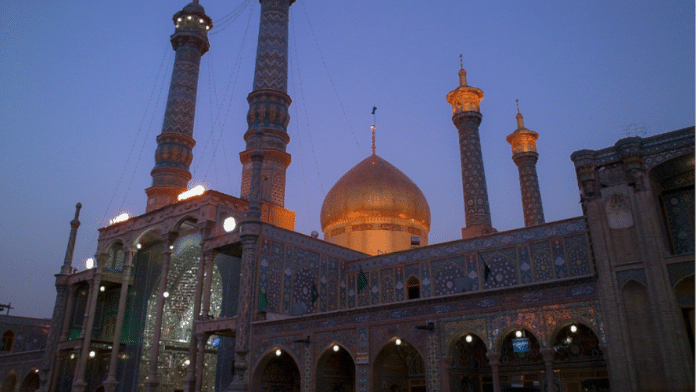Dubai/London: It’s been three days since the Iranian city of Qom banned one of Shiite Islam’s holiest shrines from holding religious ceremonies in an attempt to contain the spread of coronavirus. On Wednesday, it was still open with pilgrims pushing at fences erected to stop them kissing the gilded shrine.
The Iranian government has become the target of popular anger and ridicule over its slow and confused response to the outbreak, which has killed at least 19 people in the country so far with wildly fluctuating reports on how many people actually have the virus.
At least part of the cause appears to be an over-powerful clergy, unwilling to interfere with religious observance. Shiite pilgrims visiting a circuit of shrines in Qom and Mashhad in Iran, as well as Najaf in Iraq, have been identified as a primary source of the disease’s spread across the Gulf.
Still, the faithful continue to have access to shrines. The official news agency IRNA said that Friday prayers would be held as usual in Tehran, where the main Mosalla mosque can hold tens of thousands.
Meanwhile access to Qom, a city of 1.2 million and epicenter of the coronavirus outbreak in Iran, remains free in stark contrast to the quarantining of affected urban centers in Italy and China.
“The biggest question is why Qom has not been quarantined,” said Mehdi, a 28 year-old photographer who lives and works in Qom. “It’s getting worse with each passing day. They’re disinfecting the shrine by the hour, but unfortunately, people still go there and touch and kiss all over the place in reverence.”
Tea houses, cafes for smoking hookah pipes and gyms are shut, as well as many restaurants and stores, and there are few pedestrians on the streets, according to Mehdi. Kits to test for the virus are scarce, and a recent delivery of face masks sold out within hours. The government has begun distributing packages containing face masks, disinfectant and sanitary gloves, but supplies are insufficient to cover the whole city, Mehdi said.
On Wednesday, the normally bustling Grand Bazaar was deserted, yet people were still visiting the Imamzadeh mosques—mausoleums for the lesser offspring of Holy Imams related to the Prophet Mohammed—as well the Fatima Masoumeh shrine, according to Hamid, a driver for Snapp, the Iranian equivalent of Uber.
The problem is that people would take offense at being shut out of Qom’s holy places, said Hamid, speaking by phone from his car. “It’s a religious city” he said. “If it was up to me, I’d shut all the Imamzadeh mosques and the shrine, but people go everywhere as they please.”
Also read: Iran’s supreme leader faces some supreme problems
To be sure, there are other equally important reasons to help explain the Iranian response. There’s a shortage of medical supplies caused by U.S. sanctions and the prioritization of geopolitics over domestic health saw some 3 million face masks shipped to China that are now needed at home.
On Tuesday, the Chinese embassy in Tehran said it was in turn donating 250,000 masks to the Iranian Ministry of Health and Medical Education, according to China’s official People’s Daily.
Iran faces more disruption it can ill afford. With its oil sales hit by American sanctions, the economy has been dependent on goods exports to neighbors that are now shutting their borders. The rial, Iran’s battered currency, has fallen 11.5% since Feb. 12, according to quotes from three open-market traders in Tehran.
For Qom, pilgrimage is critical. The bustling city is visited by about 20 million domestic and 2.5 million foreign tourists per year. Now it’s the city worst hit by covid-19. Iranian state TV confirmed 139 cases nationwide by Wednesday afternoon.
On Feb. 21, the custodian of the Fatameh Massoume Shrine accused the U.S. of targeting his city with coronavirus, as “the enemy” tried to sow fear and break Iran’s resistance.
Still, “you can’t chalk it all up to officials,” said Mehdi, the photographer, speaking by phone. While the shrine and mosques were open, they are much less trafficked than usual. The problem was that believers insisted on continuing to visit.
Precisely how many cases and fatalities there are in Iran’s most religious city remains unclear. On Monday, a conservative parliamentarian from the city claimed it had suffered 50 coronavirus deaths, a figure swiftly denied by the authorities.
Yet the government’s own statistics have prompted mistrust, not least because the low number of registered cases relative to the deaths would suggest a mortality rate several times higher than the World Health Organization’s 2% estimate.
Adding to the confusion, the deputy head of the Qom University of Medical Sciences said 434 patients suspected of having the coronavirus have been hospitalized in recent days, the semi-official Mehr news agency reported on Wednesday. That would be a multiple of the government figure for all of Iran. Indeed, he himself was quarantined as a possible case.
Kuwait on Monday reported three positive cases from people who had been evacuated from Mashhad, even though Iranian authorities had identified no coronavirus in the city.
The relatively lax Iranian response contrasts with Italy, which sealed off about ten towns south of Milan and one near Venice the day after discovering a rash of covid-19 cases in the area. It also shut down the Venice carnival, one of the world’s great cultural festivals. Countermeasures taken by China, after its initial efforts at suppressing news of the virus failed, have been still more draconian. –Bloomberg
Also read: Pakistan confirms its first two cases of coronavirus




And you ask why is Iran a Cuckoo Islamic nation??? It has self destroyed itself several times since the sha was removed.